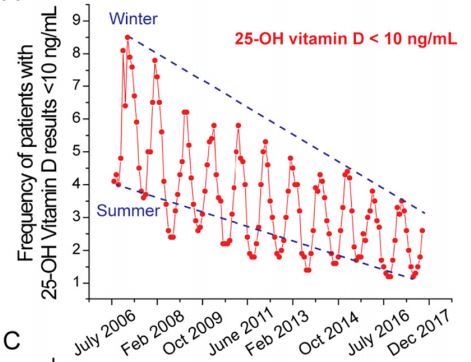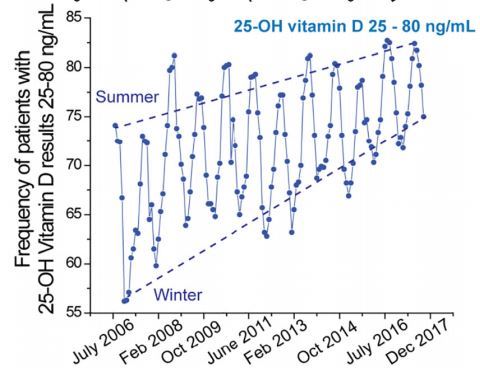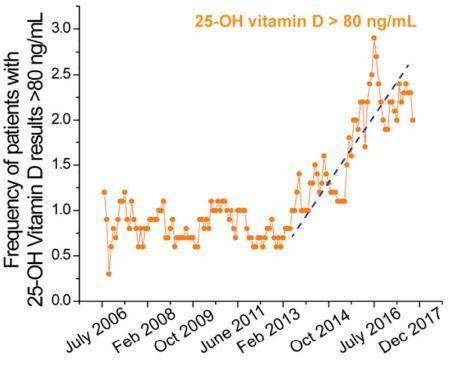Vitamin D levels at Mayo Clinic increased over a decade
10 years of 25-hydroxyvitamin-D testing by LC-MS/MS-trends in vitamin-D deficiency and sufficiency.
Bone Rep. 2018 May 23;8:268-273. doi: 10.1016/j.bonr.2018.05.003. eCollection 2018 Jun.
Galior K1, Ketha H2, Grebe S1, Singh RJ1.
This study is one of 11 others in 12 Vitamin D articles in Bone Reports Journal – 2018
 Note: Study considers > 80 ng to be toxic, VitaminDWiki disagrees
* Sleep disorders cured by 60-80 ng of vitamin D and some B vitamins – March 2013
* Autism treated by Vitamin D (80 – 120 ng) – Cannell update May 2018
* Need at least 80 ng of vitamin D if have chronic kidney disease – May 2012
* Cluster headaches virtually eliminated in 7,000 people with high-dose vitamin D and cofactors - Feb 2022 80 ng
* Dr. who got patients to vitamin D level of 80 ng - went out of business, patients became too health
* [Autoimmune diseases such as MS treated/reversed - **150 ng * of vitamin D](/pages/update-on-treating-multiple-sclerosis-with-high-dose-vitamin-d/)
Note: Study considers > 80 ng to be toxic, VitaminDWiki disagrees
* Sleep disorders cured by 60-80 ng of vitamin D and some B vitamins – March 2013
* Autism treated by Vitamin D (80 – 120 ng) – Cannell update May 2018
* Need at least 80 ng of vitamin D if have chronic kidney disease – May 2012
* Cluster headaches virtually eliminated in 7,000 people with high-dose vitamin D and cofactors - Feb 2022 80 ng
* Dr. who got patients to vitamin D level of 80 ng - went out of business, patients became too health
* [Autoimmune diseases such as MS treated/reversed - **150 ng * of vitamin D](/pages/update-on-treating-multiple-sclerosis-with-high-dose-vitamin-d/)
📄 Download the PDF from VitaminDWiki
< 10 ng - decreased to 3%

25-80 ng - increased to 75%

> 80 ng - jumped to 2.5%

In early 2000's vitamin-D deficiency was shown to be prevalent in several countries including the United States (US). Studies exploring the role of vitamin-D metabolism in diverse disease pathways generated an increased demand for vitamin-D supplementation and an immense public interest in measurement of vitamin-D metabolite levels. In this report, we review the role of vitamin-D metabolism in disease processes, clinical utility of measuring vitamin-D metabolites including 25-hydroxyvitamin-D (25(OH)D), 1,25-dihydroxyvitamin-D and 24,25-dihydroxyvitamin-D and discuss vitamin-D assay methodologies including immunoassays and liquid chromatography mass spectrometry (LC-MS/MS) assays. We also provide examples of vitamin-D toxicity and insight into the trends in serum 25(OH)D levels in the US population based on 10 years of data from on serum 25(OH)D values from ~5,000,000 patients who were tested at the Mayo Medical Laboratories between February 2007-February 2017.
PMID: 29955644 PMCID: PMC6020395 DOI: 10.1016/j.bonr.2018.05.003
